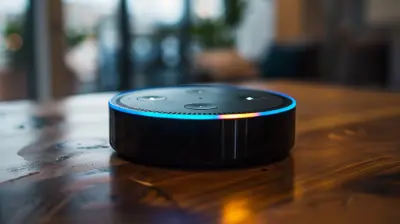The Intersection of IoT and Cloud Security
27 August 2025
The Internet of Things (IoT) has revolutionized the way we interact with technology. From smart homes to industrial automation, connected devices are everywhere. But with great connectivity comes great responsibility—especially when it comes to security.
Now, pair IoT with cloud computing, and you get a powerful combination that enables real-time data processing, remote device management, and seamless integration. However, this blend also raises serious security concerns. So, how do we keep our IoT devices safe in the cloud-driven era? Let’s dive in.

Understanding IoT and Cloud Security
Before we get into the nitty-gritty of security challenges, let’s break down these two concepts.What is IoT?
IoT refers to a vast network of physical devices—sensors, cameras, wearables, home automation systems, industrial machines, and more—that are connected to the internet. These devices collect, process, and exchange data, making our lives easier and industries more efficient.From smart refrigerators that notify you when you're out of milk to industrial sensors optimizing manufacturing processes, IoT has transformed multiple sectors.
What is Cloud Security?
Cloud security encompasses the policies, technologies, and controls designed to protect data, applications, and infrastructure in cloud environments. Since cloud computing enables businesses to store and process vast amounts of data remotely, ensuring data integrity, confidentiality, and availability is crucial.Now that we have a basic understanding, let’s talk about why the intersection of these two technologies can be both beneficial and risky.

The Growing Dependency on IoT and Cloud
The rise of IoT devices has made cloud computing almost indispensable. Why?1. Scalability – Businesses and individuals no longer need massive on-site infrastructure. The cloud offers flexible storage and computational power.
2. Real-time Processing – IoT devices generate tons of data. Cloud computing helps process and analyze that data efficiently.
3. Remote Management – Whether it’s controlling a smart thermostat from your phone or monitoring industrial equipment from another city, cloud-connected IoT enables seamless remote operations.
However, the more we depend on these technologies, the bigger the security risks.

Major Security Challenges at the IoT-Cloud Intersection
Every technological advancement introduces security challenges, and the IoT-cloud ecosystem is no exception. Here are some major concerns:1. Data Breaches and Unauthorized Access
IoT devices generate a massive amount of sensitive data. When these devices connect to the cloud, they create multiple entry points for cybercriminals. If security measures are weak, attackers can gain unauthorized access, leading to data breaches or even complete system takeovers.2. Weak Authentication and Default Credentials
Many IoT devices come with factory-set passwords that users forget to change. Hackers exploit this by accessing unsecured devices and, in some cases, gaining entry to an entire cloud-based network.3. Unpatched Firmware and Software Vulnerabilities
IoT devices often run on outdated firmware with known vulnerabilities. Unlike smartphones or computers, these devices receive fewer updates, leaving them susceptible to cyberattacks. If compromised IoT devices are connected to the cloud, attackers can infiltrate cloud systems as well.4. DDoS Attacks Using IoT Botnets
Cybercriminals often target unsecured IoT devices to build botnets—massive networks of hijacked devices used for Distributed Denial-of-Service (DDoS) attacks. These attacks flood cloud servers with fake traffic, causing downtime and disruption of services.5. Insecure Data Transmission
A lot of IoT devices transmit data without encryption. Imagine sending sensitive information through a megaphone—anyone listening can pick it up. Without proper security measures, data in transit between IoT devices and the cloud can be intercepted by hackers.6. Privacy Concerns
Many IoT devices, like smart cameras and voice assistants, collect personal data. If this data is stored in the cloud without adequate encryption or access controls, it can be exploited by cybercriminals—or even by the companies behind these devices.
Best Practices for Securing IoT in the Cloud
The good news? There are solutions to mitigate these threats. Organizations and users alike must take proactive steps to secure their IoT-cloud environments.1. Strong Authentication and Access Control
- Enable two-factor authentication (2FA) wherever possible.- Use strong, unique passwords for each device.
- Implement role-based access control (RBAC) to restrict access.
2. Regular Firmware and Security Updates
- Keep IoT device firmware up to date.- Enable automatic updates if the device supports it.
- Use security patches as soon as they’re released.
3. Encrypt Data in Transit and at Rest
- Use end-to-end encryption when transmitting data from IoT devices to the cloud.- Store sensitive information in encrypted form rather than plain text.
4. Secure APIs and Cloud Interfaces
- Ensure all APIs connecting IoT devices to cloud services are properly secured.- Implement authentication mechanisms for API access.
- Monitor API activity for suspicious behavior.
5. Network Segmentation
- Keep IoT devices on a separate network from critical business systems.- Use firewalls and intrusion detection systems to monitor abnormal activity.
6. Monitor and Audit IoT Activities
- Implement continuous monitoring tools to detect anomalies.- Conduct regular security audits to identify vulnerabilities.
- Use AI-based security analytics to detect threats faster.
7. Educate Users on Security Best Practices
- Encourage users to change default credentials.- Raise awareness about phishing threats targeting IoT devices.
- Promote responsible data-sharing habits.
The Future of IoT and Cloud Security
So, what’s next? As IoT adoption grows, so will security concerns. Luckily, advancements in AI-driven security, blockchain for secure authentication, and quantum encryption might soon redefine how we protect IoT-cloud ecosystems.Governments and regulatory bodies are also stepping in, enforcing stricter compliance rules to hold businesses accountable for securing IoT and cloud environments.
We’re moving towards a future where security isn’t an afterthought—it’s a necessity. And if we get it right, the IoT-cloud ecosystem will continue to thrive without compromising privacy or safety.
Final Thoughts
The intersection of IoT and cloud security is a double-edged sword. While the combination enables incredible technological advancements, it also opens new doors for cyber threats.Organizations, developers, and users must all play their part in securing IoT devices, enforcing strong security practices, and staying aware of emerging threats. After all, in the digital world, security isn't just a feature—it's a necessity.
all images in this post were generated using AI tools
Category:
Cloud SecurityAuthor:

Jerry Graham
Discussion
rate this article
1 comments
Kenneth Taylor
This article astutely highlights the critical convergence of IoT and cloud security, emphasizing the need for robust cybersecurity measures. As interconnected devices proliferate, prioritizing secure data transmission and storage becomes essential for safeguarding users' privacy and trust.
September 5, 2025 at 4:50 AM

Jerry Graham
Thank you for your insightful comment! Indeed, the convergence of IoT and cloud security is vital for ensuring user privacy and trust as we navigate this increasingly interconnected landscape.


